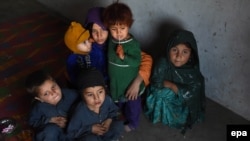A group of Afghan women who were held captive by Islamic State in eastern Afghanistan finally broke their silence and spoke about IS torture and mistreatment. They said the terror group kept them in confined quarters for days at a time.
“We were kept in dark places, not allowed to pray and our children could not cry or make noise,” one of the women told VOA’s Afghanistan Service last week.
The women were captured by IS fighters in Nangarhar province in early 2016 and were held captive for more than four months before they were released as part of a prisoner-swap deal negotiated by tribal elders in the region.
Fearing retribution from IS fighters, the women did not disclose the atrocities of the terror group for almost a year, and they finally revealed their ordeal at an event in the provincial capital Jalalabad last week, where provincial officials and citizens celebrated International Women’s Day.
For security reasons, all women requested anonymity while speaking to VOA’s reporter in eastern Afghanistan.
The prisoner swap reportedly had been approved by the Afghan President Ashraf Ghani, according to the head of the local uprising forces in Nangarhar.
Afghan security forces reportedly had captured families of local fighters loyal to Islamic State when they conducted a military operation against the group in the region in 2016. Government took them into custody for investigation.
In response, IS fighters attacked a village in the restive Kot district that supported the government and abducted several women and children after executing the men of the families.
‘We Were Starved’
The women told VOA that IS starved them in dark cells operated by the terror group in eastern Afghanistan. The group accused villagers of becoming “infidels” by supporting the Afghan government and living in government-controlled areas.
“They kept beating us and telling us that they would kill us because we became Kaafir [non-Muslim],” one of the women said.
She added that militants were fearful of airstrikes and used relocation as a tactic to circumvent the potential threat.
“They kept us moving from one place to another and at last they relocated us to Momand Dara in the Achin district,” another woman said, adding that their captors showed them videos of how their husbands were executed.
One woman from the group, who was captured along with two of her young daughters, said the vast majority of IS members were foreigners because they spoke in different languages.
“The militants had long hair, and wore masks on their faces and spoke different languages,” she said.
The women’s accounts of their captivity were confirmed to VOA by the head of the Afghan Human Right Commission in Nangarhar.
“These women whose husbands were killed by the IS lived in the group’s captivity,” Sabrina Hamidi, head of the human rights commission in Nangarhar told VOA.
After losing their husbands, these women are on their own now and have to provide for their children. Traditionally, men are the primary breadwinners in Afghanistan, particularly in rural areas. When they die, in many cases women are not allowed to remarry or go back to their parents.
They urged the Afghan government to assist them and their children.
IS Expansion
IS fighters have made inroads into Afghanistan’s eastern Nangarhar province in recent years and are active in several districts, particularly the Kot district, which has a border with Pakistan.
Last summer, the group launched a massive surprise attack against the district, killing dozens and displacing thousands of civilians from the area.
Over the years, the terror group has attacked several government installations and villages in several other districts of the province, as well. In some areas, they closed public schools and replaced them their own religious seminaries.
Recently, IS seems to have expanded it activities from its stronghold in eastern Afghanistan to other parts of country.
The group has taken responsibility for several deadly attacks in capital Kabul in recent months, including last week’s deadly attack on a military hospital that killed 31 people and wounded more than 80 others.
They set on fire two shrines in northern Jowzjan province last week, calling them heretic and blasphemous.
But U.S. forces in Afghanistan say the Afghan government has had recent victories against the group, and the number of IS fighters has been reduced substantially — from nearly 3,000 fighters to several hundred — because of joint U.S.-Afghan operations over the past year.
“We believe that there are approximately 700 members of ISIS, perhaps even less now based on the operations, that are still contained to less than three districts down in [eastern] Nangarhar,” U.S. Brigadier General Charles Cleveland, a spokesman for NATO’s Resolute Support Mission in Afghanistan, told reporters in Kabul last week.
-- Written by Noor Zahid and Zia-U-Rahman Hasrat for Voice of America




